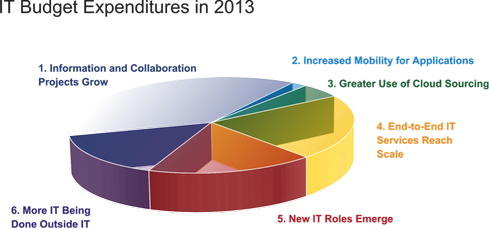Organizations of all types struggle with effective IT budget allocation. This often happens because the IT team doesn't understand the budgeting process, and the finance team doesn't understand IT.
IT management needs to first have a solid understanding of budgeting concepts to effectively use the IT budget as a management tool. Then, they must focus on business needs and how the IT organization can address these needs through the use of IT. Finally, IT management should communicate the approved IT budget to all stakeholders to share the information about available resources throughout the organization.
There are two IT budget allocation strategies:
- IT budget is formed as a percentage of revenue or on the basis of costs per employee; in this case, IT budget usually ranges from 2% to 4% of total income.
- IT budget is formed on the basis of the RGT (Run, Grow, Transform) model. This means the whole IT budget is split into three parts depending on the project development stage of run, grow, or transform. The model has drawbacks, but its advantages outweigh the disadvantages when it comes to IT budget planning.
According to industry analyst firm Gartner, companies spend up to 66% of their IT budgets for project launch initiatives (i.e., on what needs to be done to implement new IT systems). The remaining funds are split 50/50 between maintenance and new research and development (R&D).
This means most companies can allocate only 17% percent of their budgets for R&D needs. When you consider that companies typically generate 70% of company income as a result of R&D efforts, you can see a clear imbalance.
Dynamic market conditions, changing technologies, and continuous improvement require more IT financial transparency than ever.
Demand-side drivers of higher IT spending as a percentage of revenue include:
- Highly integrated IT components in the product suite
- Higher service levels for mission-critical systems
- Higher usage of knowledge workers
- Decentralized IT environment.
IT management is constantly under pressure to understand how to free funds from an already allocated budget. They are reallocating resources within the budget through traditional process automation, cost optimization, service management, and externalization.

Therefore, the question becomes: How can we increase the share of R&D in the IT budget of a company without changing the desired value of deductions from the IT budget – thereby achieving the highest efficiency of R&D and increasing the company's income? The answer lies in increased attention to the quality of IT projects at and before their launch. Incorporating testing and requirements analysis early on will help to reduce unnecessary spending, allowing companies to use funds for other important projects.










